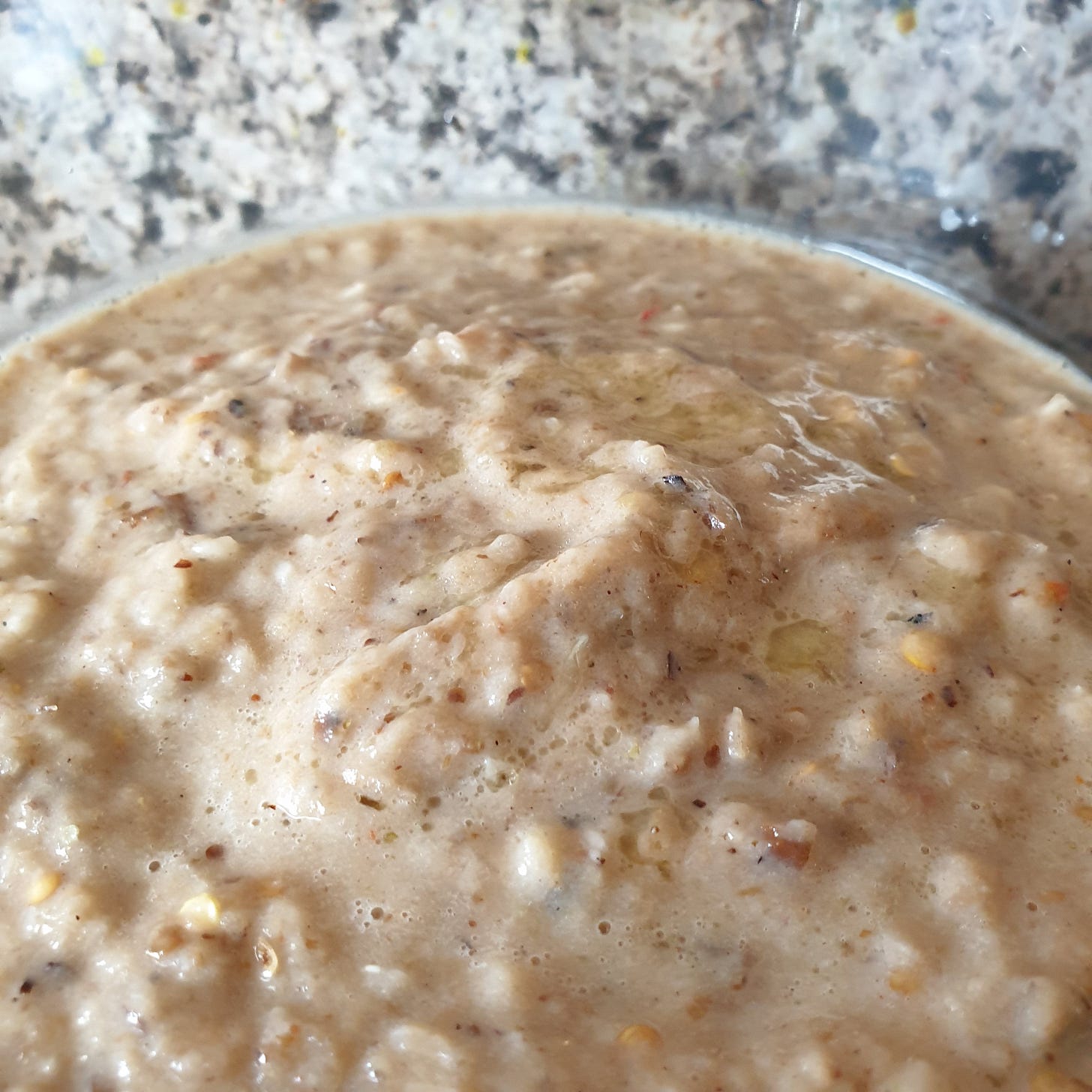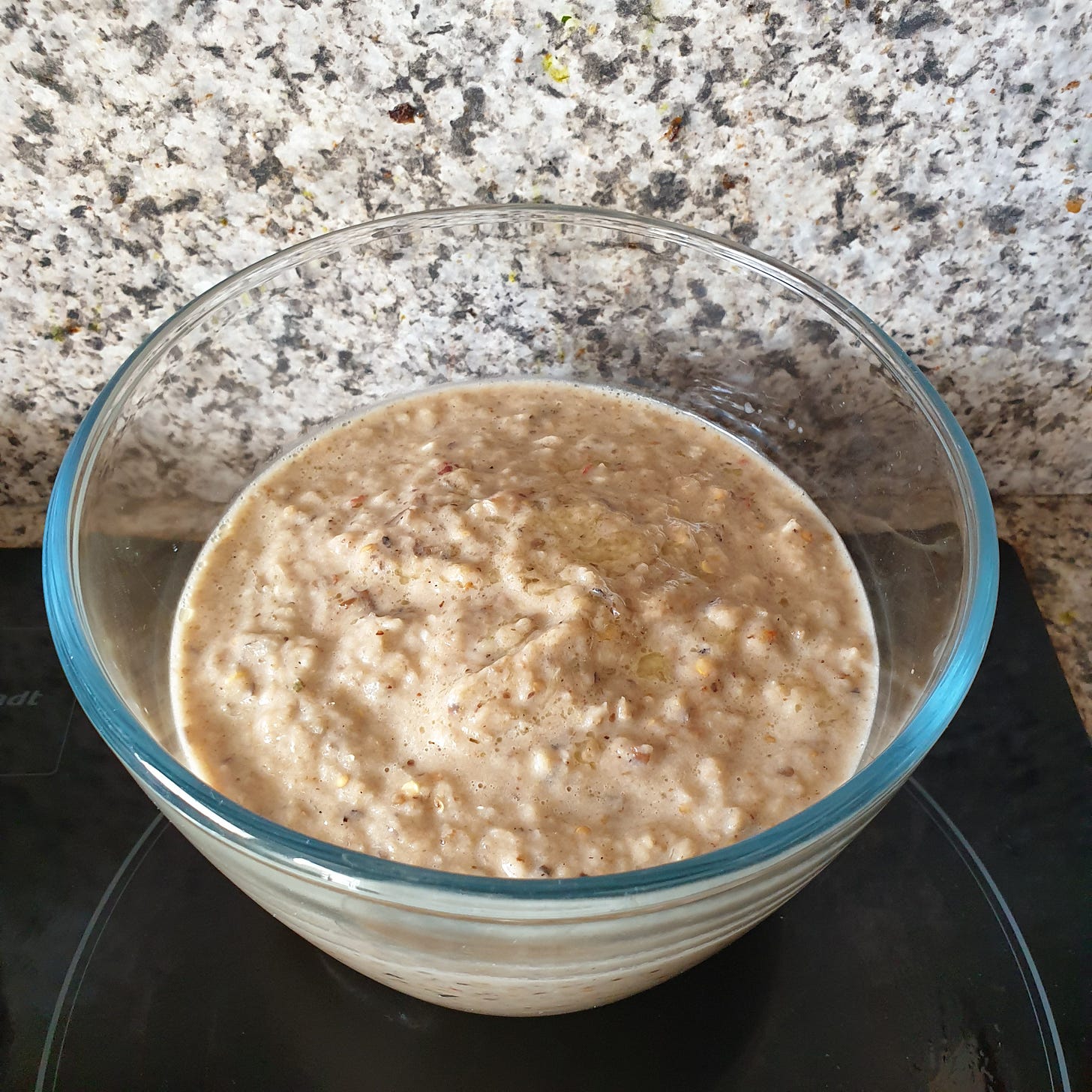Saving frozen eggplants with light fermentation and a dip
Another express recipe to save frozen vegetables from spoiling, after my refrigerator and freezer stopped working. This one gives you fermented eggplants and something similar to a baba ganoush.
Preparation: 5 minutes
Cooking: up to 2 hours

If you haven’t read the first post of this mini-series, saving frozen spinach and cauliflower with saag gōbhī, here’s a refresher. We have a 21-year old side-by-side fridge freezer at home, which we bought along with other appliances and furniture while acquiring the apartment. I sometimes wrote that I considered the amount of frozen food I had stored as an operational risk. I was half-joking. To mitigate this risk, we had gradually emptied the freezer and the fridge, to eventually turned it off before leaving for a hand of days. When we came back, I deep-cleaned the fridge and the freezer compartments. I returned from the grocery store with 11 kg of frozen veggies to help the freezer return to its set temperature, only to find that the appliance was short-circuiting, and could not be used. The timer to cook all frozen vegetables before they would spoil started.
Among other frozen vegetables, I had bought two bags of grilled eggplants —1 kg each. I had cooked one on the first day, with Indian spices. It was awesomely simple and delicious, until the last bite, and I’m sorry that in the hurry I took no pictures. However, I realized I wouldn’t be able to eat 1 kg of cooked vegetables at every meal. Not even on every day. So I changed my approach for the second kilogram of frozen eggplants.
Disclaimer: in this mini-series, time and quantities are often approximated, because I was time-constrained. The countdown to wasting the food was ticking, and I was investigating how to repair the fridge freezer in parallel. I took no notes and I shot only few pictures. The articles of the series skip the usual “About …” and “Here’s a tip before you go” sections. On the other hand, they feature a new “Preservation” paragraph, specific to the constraints of having neither a fridge nor a freezer.
Ingredients
1 kg frozen roasted sliced eggplants
200g frozen chopped yellow onions
6-10 garlic cloves
Olive oil
Salt
Preparation
Since most of the ingredients are sold chopped, there’s very little left to prepare for the two recipes. The Cooking part incurs a long and slow heating phase of the eggplants, so you can definitely start with the unique step below in parallel.
Peel the garlic cloves, then chop them

Cooking
This is a slow process, especially if your roasted sliced eggplants are still frozen. I used one of my non-stick pots, however a stainless steel one would have done well, too. As mentioned in the Preparation section, you can parallelize (though you won’t really save much time overall) by proceeding with Cooking steps 1 to 4 below before returning to the Preparation steps.
Heat your pot on low temperature
Add the frozen roasted sliced eggplants and the frozen chopped yellow onions
Pour two soup spoons of olive oil
Cover and cook until the eggplants start to soften and release their juice
Add more olive oil, the chopped garlic cloves, and two pinches of salt; stir
Cover and cook until either the garlic starts to turn brown or the eggplants start to loose their shape
Transfer half of it to a mixer or a blender, with the maximum juice possible; mix (or blend) with additional olive oil if needed
Stir in more salt to the other half remaining in the pot, then transfer to a glass jar

The eggplant spread is better enjoyed cold than hot. If you can’t cool it (either because you have no refrigerator, or the outside temperature is too high), you can use it as a sauce for pasta or rice. If you manage to cool it, you can serve it as a dip; it is also great for spreading on bread. It is somehow similar to baba ganoush, a typical Levantine appetizer — however, the present recipe lacks tahini, an ingredient which gives a distinctive flavor.

The other half contains more salt to trigger the fermentation process. See Preservation section below.
Preservation
With neither a fridge nor a freezer, I had to find another way to preserve the dish I had cooked. I knew I could eat the mixed spread over the next days, and I was fortunate the outside temperature was around 10°C maximum during daytime, so I managed to keep it for two days. In the past, I had delighted my mom (and myself) with fermented eggplant, so I choose to try doing so with what I had cooked. As mentioned in the last Cooking step, I added extra salt to the cooked sliced eggplants, then I transferred them to a glass jar. As you can see on the pictures, I filled it to the top. It’s a bad idea, don’t do that! The fermentation process releases gas, which increases the pressure inside the jar. Two days after closing the jar, I noticed it was leaking a greasy liquid. I cleaned the shelf, the jar, then I put the latter inside a larger container. On the following day, there was the same liquid in the container; I tasted and it was a salty mix of olive oil and cooking juice which had started to ferment. This was great enough to pimp a salad dressing. However, I had to regularly pull on the rubber strip to allow some gas to leave. So, do not make the same mistake as I did, and leave extra room for the gas inside the jar — 2 to 3 centimeters from the lid should be enough.

After a week, I opened the jar and I started to eat the fermented eggplant. It was good, and I don’t know exactly how far it missed being “great”. It was salty, it had the typical fermentation taste, however it was just… good. Anyway, the goal was to preserve the food without a refrigerator, and this was achieved.
I cross fingers you never have to fast-cook such amount of vegetables. Even if you never get into the same situation, you may find yourself with an unplanned meal to prepare, with little options — in such case frozen vegetables can surely help. Don’t take my first experiment at preserving with jars as a manual: educate yourself separately, be careful, and consume the content of your jars quickly.
If you’ve tried the recipe, and would like to comment (whether you loved it, or hated it), please do so! I’m welcoming ideas, even if it will take a while before I can resume with my cooking pace. I need to find a new freezer, first! Stay tuned for the next “episode” in this mini-series about saving frozen veggies with express recipes.




aaah I love baba ganoush! The end result looks yummy!